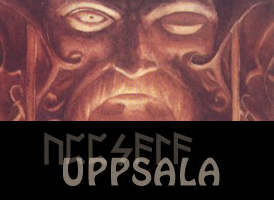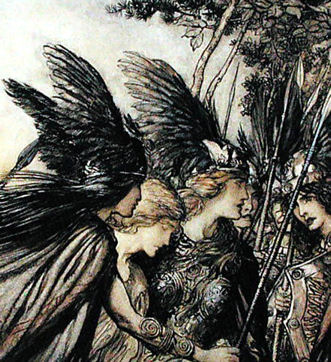
Odin
Loki
Berserkergang
Valkyries
Alfish Worship
Runes
Asatru
Factions in Asatru
Heathen
Mysticism
Please help me continue to write new books, write new blog posts, and keep this site ad-free:

VALKYRIES
"In the shade now tall forms are advancing,
And their wan hands like snowflakes in the moonlight are
gleaming;
They beckon, they whisper, 'Oh! strong armed in valor,
The pale guests await thee - mead foams in Valhalla.'" -
Finn's Saga
Valkyries are female spirits of battle who serve Odin. The name valkyrie means literally "Chooser of the Slain". They apportion victory in battle according to his commands, and scour the battlefields for those who are particularly brave, or show particular skill in the arts of combat. When such warriors die, the valkyries then carry them over Bifrost, the rainbow bridge, and to Valhalla. Once there they also serve the slain warriors meat and drink. (This should not at all be seen as a servile role, rather just the opposite. Sometimes in viking society a queen would serve a particularly honored guest herself, as a sign of great respect, and it is in this sense that the valkyries serve the einherjar who feast there.) Another function the valkyries serve in Valhalla is to guide the warriors in their battle-training, and to heal and/or reanimate them after a day of battle-practice. When the Northern Lights were in the sky, our paleopagan ancestors said that it was caused by the light reflected from the shields the Valkyries were beating their swords against.
But there is more to their nature than this. Valkyries are sometimes seen as imparting deep lore and wisdom to certain humans, as the valkyrie Sigrdrifa does in the poem Sigrdrifumal. This lore seems to be concerned with galdr, and with battle, and with right conduct. Valkyries are also seen as providing protection for certain favored warriors either directly shielding them in battle or providing warnings or protections in dreams, such as one warrior experienced when he dreamed a valkyrie removed his innards and replaced them with straw, to render him invulnerable in a coming battle. They also give warnings of battle via dreams and visions, and also of impending death.
It seems that in certain cases, the valkyrie might become identical with the fylgja entity (see the article on Asatru). In such a role, the valkyrie guides and protects her chosen human, and may become his lover. She teaches him the ways of Odin, and brings him wisdom and inspiration from the god, and when the time comes she kills him and brings him home. This kind of relationship can be seen in the Volsunga Saga, between Sigurd and Brunhilde/Sigrdrifa, and in the Lay of Helgi, and hinted at in the story of Wayland.
It would seem then that valkyries are the intermediaries between the human world and Odin. The carry out his will in battle, and as pertains to certain individuals. They bring his inspiration to the world of humans, and carry certain humans back to Odin. Individual valkyries seem to have individual functions, reflected by their names. Many names, such as Hildr, Hlokk, and Gudhr simply mean "battle". Other valkyries seem concerned with the fastening or releasing of fetters. Such are those like Herfjotter, "war-fetter" and Friagabi, "giver of freedom". There are also others such as Mist, meaning "mist" and Skogul, "rager". The number of valkyries is given differently in different sources, and does not seem to be a standardized thing, though many modern researchers try to read some deep meaning into the number. I think the answer to the question "how many valkyries are there?" is "as many as are needed".
Valkyries are often called swan maidens, and are said to be able to become swans with the aid of feathered cloaks, much in the manner Freya becomes a falcon with her falcon cloak. (There is some thought that the stories of swan-maidens and the stories of valkyries originally referred to two different kinds of otherworldy being that later became identified as one. However the mythologist D. L. Ashliman definitively states that this occurred in the heathen age, therefore it is a heathen perspective.) In this respect they are a sort of a fairy being. They can be captured by stealing their swan-cloaks while they are bathing, as Wayland did, though they are prone to leaving their husbands and seeking out battle again, or their old homes. There are a few standardized stories that are told of valkyries as swan maidens that have survived as folklore, outlined as follows:
1)A man happens upon swan maidens bathing, and takes one of their cloaks. (This is the story of Wayland the smith as well.) She becomes his wife, losing the company or her sisters. After some years of wedded bliss she finds where her husband has hidden her cloak, and the sight and feel of it recalls to her the freedom and glories of her past. She puts on the cloak and flies away, back to the land "East of the Sun, West of the Moon" (a fairly generic term for fairy land, or the world Beyond). This devastates the husband, who searches the world high and low for her. He eventually meets a strange old man, often called The King of the Animals, who gives him counsel (and seems to be a folkore survival of Odin) and tells him how to find the land East of the Sun and West of the Moon, and how to win the swan maid back when he gets there. The man goes there, and is met by the maid, who greets him joyously. She tells him that he can win her back if he can make it through either one or three horrendous trials. These trials are given either by the swan maiden herself, or her sisters, or aunts, or other relatives. When the man wins through the trials the swan maiden once again becomes his wife, and sometimes her relatives come to live together with them.
2)A hero or king wins a swan maiden as a wife, and she leaves her sisters behind to live with him. They live together happily for sometime, until she is killed by a rival woman, who also desires the hero/king. Through strange means she identifies her killer from the world of the dead, just before her rival and the king are married, and through magic she manages to come back to life and do away with her rival instead.
The close parallels these stories have with stories of valkyries, such as Sigurd's or Wayland's stories, indicates that they are good heathen models for those Odinists who work also with valkyries to relate to them by. It might also be noted that human women, often the daughters of kings, are referred to in history and mythology both as valkyries. The Arab traveller and author Ibn Fadhlan mentions a priestess amongst the tribe of the Rus he refers to as an "Angel of Death", who had a role in choosing who was to be sacrificed. It would seem likely then that human priestesses could take on the role of the valkyries. This is certainly not without precedent in Norse history, as spae-wives would often invoke spirits for different religious or secular functions.
It would be a good idea for those who are deeply devoted to Odin to consider seeking out the valkyries, as a means of becoming closer to the god. And as our stories tell us, sometimes they are there for the finding. And as I can tell you, such relationships are always worth the trouble involved.